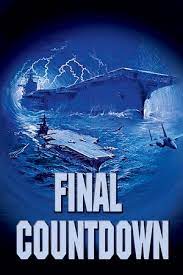
In 1980, the aircraft carrier USS Nimitz is leaving Pearl Harbor for naval exercises in the mid-Pacific. The ship takes on a civilian observer, Warren Lasky (Martin Sheen), a systems analyst working as an efficiency expert for the U.S. Defense Department. At sea, the Nimitz runs into a strange electrical storm vortex. The radar stops working and everyone is in agony for a time. Not sure what’s going on and out of radio contact, Captain Matthew Yelland (Kirk Douglas) is afraid there may have been a nuclear strike on Hawaii or the U.S. mainland. He launches an RF-8 Crusader reconnaissance plane, which photographs Pearl Harbor, but the picture shows a row of ships that had been destroyed in the Japanese attack in 1941.
When something appears on radar, Captain Yelland launches two Grumman F-14 Tomcats. The patrol witnesses a civilian yacht being strafed by two Japanese Mitsubishi Zeros. The F-14s shoot down the Zeros to protect the Nimitz. The sailors rescue from the Yacht U.S. Senator Samuel Chapman (Charles Durning), his aide Laurel Scott (Katherine Ross), and her dog Charlie, plus one of the downed Zero pilots (Soon-Tek Oh).
Commander Owens (James Farentino), who is an amateur historian, recognizes Chapman as a politician who could have been FDR’s running mate during his final election, had Chapman not mysteriously disappeared just before Pearl Harbor.
The Japanese fleet is discovered farther north, poised to launch its attack on Pearl Harbor. The crew of the Nimitz are now certain that they have been transported back in time to the day before the war in the Pacific began. They could destroy the Japanese fleet with their modern weapons, but that would alter the course of History. The American civilians are not informed of this. The Japanese pilot is likewise kept in the dark, but during questioning, he gets his hand on a gun, kills two marines, and takes Scott, Owens, and Lasky hostage. He will kill them unless he is given access to a radio to warn the Japanese fleet. But Owens describes the secret Japanese plans for the attack and the pilot is so stunned that he is easily overcome.
Chapman is outraged that Yellan knows of the coming attack but has not told anyone else, and he demands to be taken to Hawaii in a helicopter to warn the Navy brass. Instead, Yellin orders Owens to fly the civilians to an uninhabited island in the Hawaiian chain. Chapman uses a flare gun to force the pilot to fly to Pearl Harbor. In a struggle, the copter is destroyed and Owens and Scott are stranded on the island. The Nimitz prepares to launch an attack on the Japanese fleet, but the time vortex returns. The ship and its aircraft are returned to 1980, leaving the past unaffected. Returning to Hawaii, Lasky is greeted by his boss, who sent him to the Nimitz in the first place. It is Owens, and with him is Laurel Scott, both forty years older and quite rich.
The film was produced by Peter Vincent Douglas, son of Kirk Douglas, and Lloyd Kaufman, and directed by Don Taylor. It was mostly filmed on board the USS Nimitz, where the blast from launched fighters blew the camera and cameraman a good distance down the deck, until they learned where to place it. It performed quite well at the box office, but reviewers seemed more interested in the ships and planes than in the story. The U.S. Navy was quite happy to co-operate with the studio. In fact, 48 crewmembers of the Nimitz appeared in the movie. An unusual dogfight featuring planes from the Forties and the Eighties was almost a disaster. In a scene in which an F-14 pulls out of a dive just before crashing into the sea, the scream of the jet added in post-production was the real scream of the pilot’s wife, watching it happen.
In Hungary, communist at the time, the movie was banned because it glorified the U.S. Air Force. But there were copies circulated in which a scene about a Russian trawler spying on the Nimitz was delicately excised. Scenes of the attack on Pearl Harbor used film from Tora! Tora! Tora! (1970). The production had to wrap early so the helicopters and crew could be used in the ill-fated Iranian hostages rescue attempt. The poster of the movie was hung in recruiting offices. Soon-Tek Oh’s casting of a Japanese pilot was criticized because he was Korean, not Japanese, but Korea had been part of the Japanese Empire since 1905, and several thousand Koreans were in the Japanese forces during World War II.
